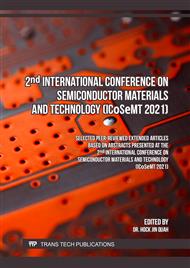p.49
p.55
p.61
p.67
p.73
p.81
p.87
p.95
p.103
Impacts of Wafer Doping Type on Structural and Optical Properties of Black Silicon Fabricated by Metal-Assisted Chemical Etching
Abstract:
In this work, the impacts of wafer doping type on structural and optical properties of black silicon (b-Si) fabricated by metal-assisted chemical etching (MACE) process are investigated. P-type and n-type mono-crystalline silicon (mono c-Si) wafers are etched in an aqueous solution of hydrofluoric acid (HF), silver nitrate (AgNO3) and deionised water (DI H2O) at room temperature and various durations from 5-20 minutes. Surface morphological results demonstrate the formation of b-Si nanowires (NWs) with average lengths of 0.4-0.8 μm for p-type wafers and 0.8-3.0 μm for n-type wafers. The higher length of the NWs for the n-type wafers is due to the minority charge carriers, which lead to a higher etching rate during the MACE process. Within the 300-1100 nm wavelength region, weighted average reflection (WAR) for the p-type and n-type wafers decreases to 6.6% and 6.4%, respectively, after 20 minutes of etching. The corresponding improvement in broadband light absorption results in maximum potential short-circuit current density (Jsc (max)) of 38.2 and 38.8 mA/cm2 for the p-type and n-type b-Si, respectively, which is an of enhancement of 39.9% and 42.1% when compared to the Jsc (max) of planar c-Si reference.
Info:
Periodical:
Pages:
73-79
Citation:
Online since:
May 2023
Keywords:
Price:
Сopyright:
© 2023 Trans Tech Publications Ltd. All Rights Reserved
Share:
Citation:



